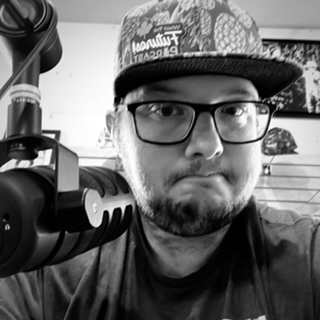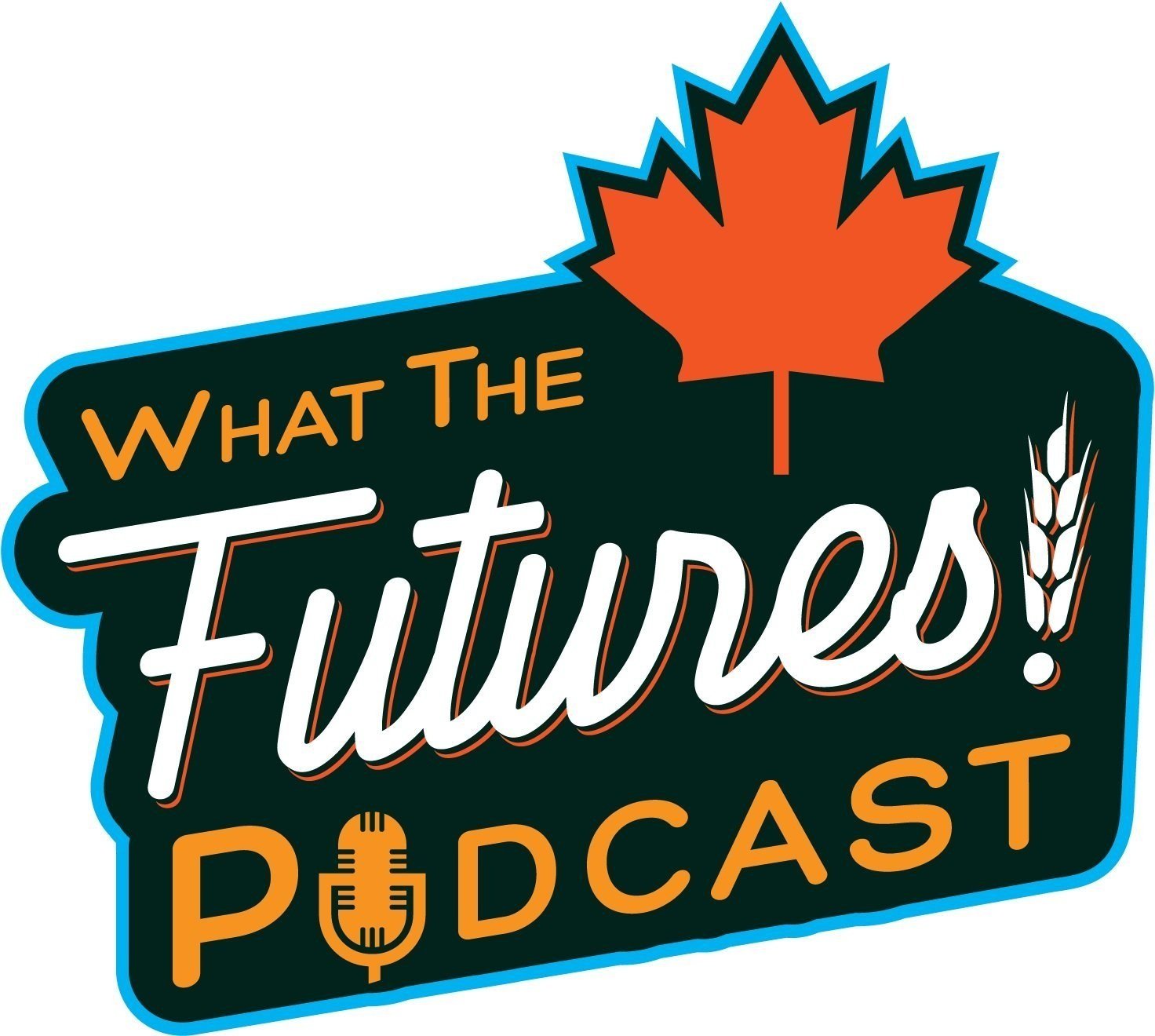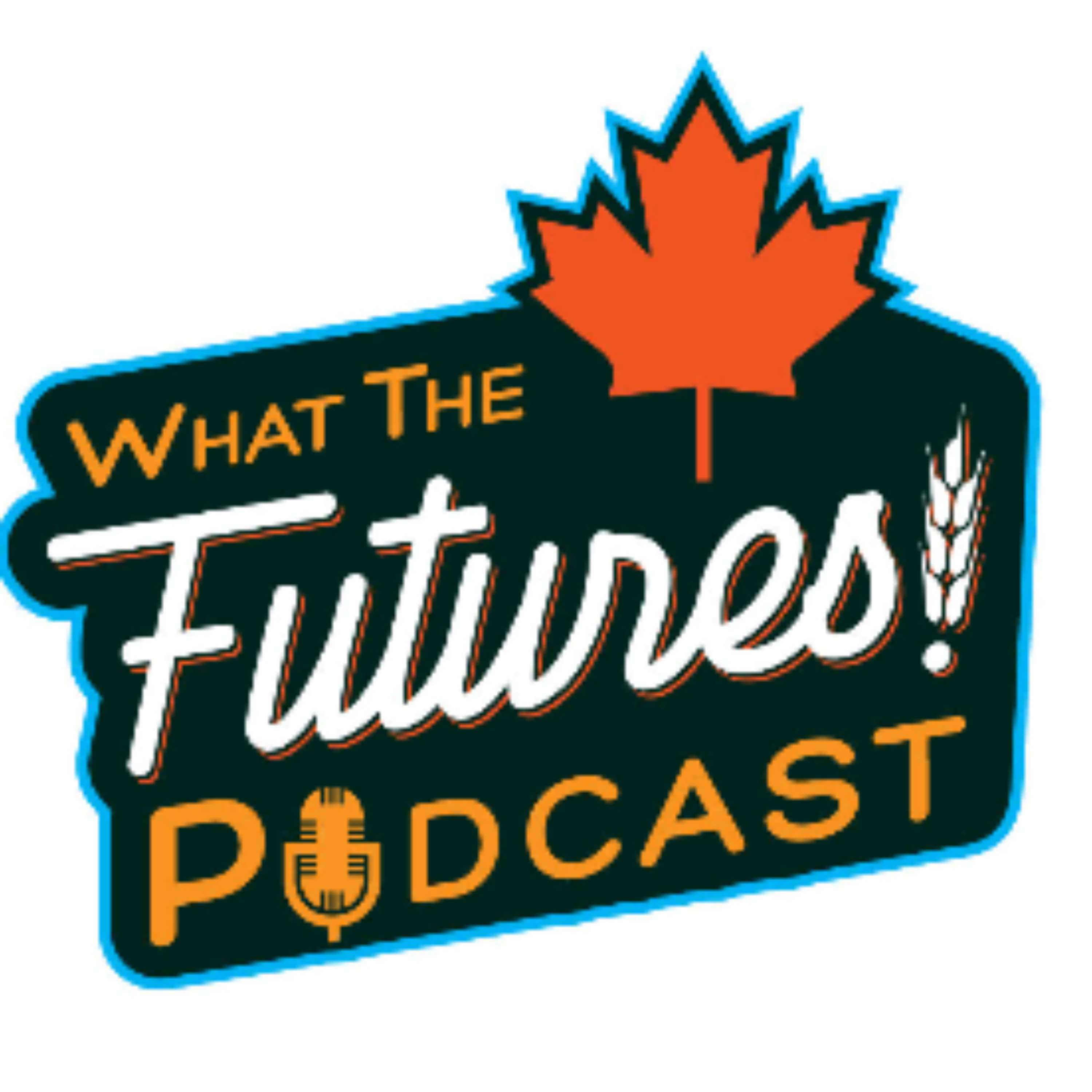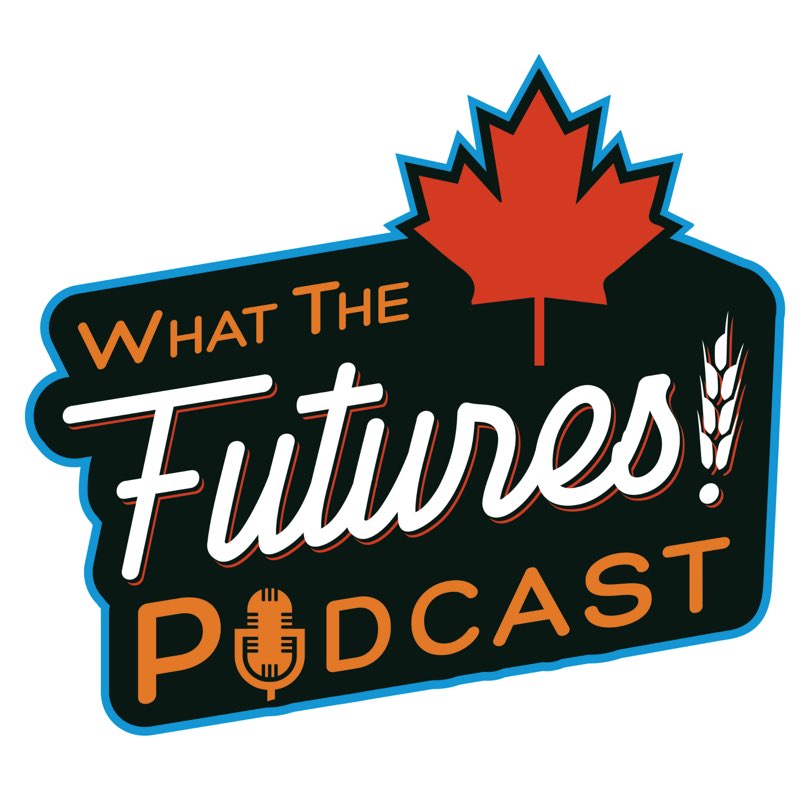Episode Transcript
[00:00:00] Speaker A: Well, folks, let's talk about my week at Egg in Motion. Tremendous week at the UPL booth, raising money for the Crisis Helpline, Farmer Stress Helpline. I spent a great week sold out of hats. Had a great week, engaging with listeners. Of course, we give out lots of free swag always at Egg in Motion. Let's see what we got here in episode 85.
Hey, folks, welcome to the what the Futures podcast, your quick guide to better farming decisions.
Hey, folks, welcome into episode 85 of the what the Futures podcast. Of course, I'm here in the UPL booth at Egg in Motion this week, usually in the UPL studio, but not, not this week. It's a rare, rare time for what the futures to be. To be on the road. It's been a great week here at Egg in Motion. You know, I know it hasn't been a perfect summer for weather, but it's pretty darn good here this week. We've got low to mid 20s, very had some sunshine this afternoon, as you can see. It's been a good show. Had some fun with John Deere Tuesday afternoon. You'll see those videos over the next few months. Let's just say it's fun sitting in new, big, fancy new equipment. It was really good there. Also, you know, the folks over at upl, we've had breakfast. We had a crop marketing reunion here on Tuesday. You know, we also had coffee in the morning here. It's been a good, A really nice week. Really nice week. Okay. It's always a little bit of a challenge here to put together a podcast episode when you got a busy week. We've done some really cool things. The hats here again, Paisley, nine years old, designed a wonderful hat for us, raised just a ton of money. I don't have the total here quite yet as a recording, but I just thank each and every one of you that stopped by, put down a couple of pesos here, a couple of dollars to buy a hat and raise money for the, you know, the farm crisis, the stress line, you know, the help line. It's available 24. 7.
It's in the.
In these hats. 186 6, farms 01. And I just appreciate everyone, the conversations and of course, raising money for a great cause. You know, I said it last week that my positive moment for this week would be chatting with farmers. And that is definitely, definitely the highlight. Of course, I brought Finn for setup day. Finn and Willow were here and it was cool. You know, Finn loves equipment, so he was. His eyes were huge and he really enjoyed checking out the Equipment and, and seeing things with grandpa as we're doing a family setup and, and then of course, Willa, she snagged a freezy instantly and she was really interested in the animals and the cows and all that good stuff. So. So it's been a great week. Been a great week. Now I know from a crop marketing perspective, it's been a bit of a rough week.
And you know, the farmer dialogue has been, been phenomenal. I think the biggest question, most asked question is, you know, what do I do about fertilizer? Do I buy fertilizer? I talk to farmers that have bought their fertilizer needs for next year. I've talked to farmers that are thinking about it. I've talked to farmers that want to make a decision here right away. History tells you, you know, you commit to it in the summer, I don't know, 95, 97, 98% of the time it's the right call. And so this year, I don't know if this is a one off. I just think you'll get multiple stabs at it and multiple tries. Do I know that with a hundred percent certainty? No, but that's my feeling right now. So, you know, if you bought it again, you might be the smartest person here in the prairies.
If you didn't buy it yet. I'm kind of with you just trying to stay patient here, just, just a little bit. The second biggest question has been about the wheat markets. And as of recording here, the markets are closed. The entire show is actually closed. I'm, I'm staying here a little bit later on Wednesday to, to get, get something down for you for Friday here for this week. You know, wheat markets lost a penny today, trading at 620. Of course, we did hit a high of 680 and change here a couple weeks ago. I guess that's about a month ago now. The highs in June again hit a high here in early July, right around the 670 level. So people are asking like, what do you do when it comes to wheat marketing? What do you do, you know, with new crop around the corner? And I'll tell you folks, farmers are undersold. Not undersold in the fact that, hey, you had a market rip higher and now you're sitting here, you know, you didn't do anything like the market. It gave us a couple small chances, but it didn't feel good. And that's what happens, right You, I think Susan Stroud was on the show, you know, weeks back now saying when the marketing, when you're not feeling confident in the markets, when you're not feeling confident in your decision, that's often the right time to be a seller. And man, I have to look up the date of that episode. But I believe she may have called the high in the wheat market on that one.
And I said it in my talk.
I think that from marketing wheat, I understand Russia and Ukraine have a slightly smaller crop compared to last year. I understand, you know, the same thing in, in the US and Canada we, we have a smaller, it looks like a smaller crop here across North America as well. And so, you know, maybe we're not extremely bearish. The wheat market will still make a harvest low.
But I think the big problem for me is that the basis levels for new crop are not, not nearly attractive enough and, and I don't even know if you'd call them honest numbers yet.
I think basis comes here. Maybe a few companies are a bit, a little bit more transparent, but there's some pretty crappy basis levels out there and you know, resulting in a net price that just does not get anybody excited. The wheat marketing I believe is a series of small wins that you're going to have to put together.
I said it in my talk on Tuesday. But you know, maybe you get a little, maybe you get a basis chart and figure out a basis strategy, maybe set some tight targets on futures rallies. You don't try to pick up 25, 30 cents in a futures rally instead of waiting for that big move higher.
Maybe you make smaller decisions. Maybe you take, maybe you do, you normally do 10% sales or something like that, 20%, but maybe you do 5% or you make some smaller decisions this time around. I'm not sure exactly, but that's what I would look at. I think futures you gotta be, you gotta reward the small gains that you get, pick out those levels of resistance, get some sales on. You know, you've heard this before. The market does not care about your break even.
The market does not care that you're only going to get 50 bushels instead of 60 bushels. You know, that is true. The market doesn't care. It's just really hard to pre sell wheat here at a loss. That's been my struggle here as well.
You know, maybe you got a brokerage account and there's a few little strategies you can look at there, you know, tinker some strategies, get yourself to a level of, you know, profitability or break even. Yeah, that's what I would be looking at here for wheat. The, the fertilizer has been a big One wheat's been another big one and then pulses. You know, I think the yellow pea market is one of bigger concern for me just because tariffs in China, I know China's buying a little bit of peas from us, but that's a worry. India being out of the market here on the buy side's a little bit of a worry as well. And so I know you don't want to sell $9 peas, but a lot of farms like to move their peas off combine or for cash flow. How bullish should you be right now? You know, when I look at the crop marketing, the crop marketing handbook and I look at the time of year, you know, this is a time where, and I'll talk about this in eating your veggies, but you really need to dial it in on, on cash flow and you really need to, you know, pick those crops that if you have to sell something for space or for cash, it's decision time there. All right, so I, you know, I've been obviously at the show all week here and, and I would say, I would say the general mood here from, from farmers is, from a crop marketing perspective is, you know, not a lot of, of of optimism price wise. Understandably we are in sideways to lower trends right now in a lot of these markets.
But you know, that resonates, you know, from, from the crowd. I, I, I talk to farmers about being bold, you know, being bold in decisions, being bold on, on your crop marketing.
We've been flying the crop marketing pirate flag here all week and, and just that, you know, I know it, the outlook is, is a bit difficult right now. It certainly was worse. Especially you think Canola a few, a few months ago. That canola situation's a lot better.
Obviously we saw a rally up to 750 off November. Like if you had that on your bingo card months ago, you would have made a lot of money. Right? So it's, it, these markets don't always go, go down. I would say that farms are kind of prepared for it and that's influenced crop marketing. That's why there's not a lot of sales on the drought and the low prices and everyone's buckled in for what could be a challenging 6 months, 12 months ahead.
From a price perspective. You know, I would say look for those little wins. Look for the little wins. Look for the little, the little victories. Make sure you spend that time in the office every week and, and take care on some of your crop marketing. You'll find those little wins. The markets been telling this to guys the last Couple days. Like they have highs and lows.
You want to make sure you get more of those sales done at the highs and avoid those lows. And if you can do that over the year, you know, you'll feel pretty darn good about yourself again. The market will only give you so much. Alrighty, the other things here for FragginMotion. Yeah, I guess I'll just. This is a little bit of an aside, but we are running an online auction. Go to Ryandenee Ca. Check it out, Check it out there. We are raising some money for the care home, you know, my local care home in Bellevue, Saskatchewan. So go to the website, check out the auction there. We do have available to bid on is a crop marketing conference ticket.
We have a subscription to the lunchbox crew there as well. Ian, I'm gonna message you because we didn't talk about it here when we met up today, but I'm gonna message you on that one.
So that's available. The crop marketing ticket also includes your hotel. And then we have some consulting. I do one on one consulting with farms. And so we do have a package there as well available. And then, yeah, if you have five or ten bucks that you want to donate, you don't want to bid, but you wouldn't mind donating. It's all on that. On that link as well. Okay, so check that out. All right. Okay. So we. We went through some positivity already. When it comes to come to the week, I'd say my positive moment, you know, I didn't realize. So Finn's two and a half years old. I didn't realize how excited he would be at the farm show. Finn loves playing tractors and combines. He loves green equipment. And he showed his true colors here at the show. Where I'm surrounded here today, I've got multiple shades of orange. I see red, I see blue.
I see a pukey lime green around me.
And Finn, his bias is showing. His farm influence is showing because he's pointing out the green, the dark green ones, even when they're off in the distance, he wants to go and check those ones out. So.
So it was great to see his eyes light up. And we know for next year to make sure that he gets a morning here at the show because he didn't want to go home. He was having a lot of fun.
All right, folks, I'm here at the John Deere booth with Taylor Wallace from Unity, Saskatchewan. We're down at Egg in Motion. Taylor, how is the summer going?
[00:12:15] Speaker B: Summer's going real good, but real Quick. I mean, we're already at the midpoint of July.
[00:12:19] Speaker A: Yeah.
[00:12:21] Speaker B: But yeah, no, I think something's going well, but we're going to blink quick here and then it's going to be time to get calm minds out and get to work again.
[00:12:28] Speaker A: So last year I'm driving through Unity. I accidentally opened my mouth not doing it this year. Do we want to talk about the crops at all or.
[00:12:36] Speaker B: No, we can. I mean, so far right now, I think we caught rain just at the very tail end of where we needed it.
[00:12:43] Speaker A: Yep.
[00:12:44] Speaker B: And crops look good for the most part.
Maybe not a record crop by any stretch, but we're definitely at a point where I'm pretty happy with it. Good.
[00:12:53] Speaker A: Yeah. Well, a little bit of a rally in prices and a good crop and we're off to the races. So we're at the John Deere booth. Taylor, what stands out for you here when you're looking at the green paint?
[00:13:04] Speaker B: Well, you know what I'm a big fan of is their technology integration. I think JD Ops and the back end stuff and how to analyze equipment is top notch. It's great to look at those numbers, see where your running. We don't, we don't have a lot of John Deere equipment on the farm, but we do use JD Ops to track a lot of things. And that, that, that piece is really helpful.
[00:13:25] Speaker A: Well, I know, I admire how sharp you guys are on the numbers. You guys pay attention to what you're doing, you know, from a decision aspect, you're analyzing that. So I think that's great. And, and that farms should not should, but something that many should be doing and looking at.
So anything stand out from a JD Ops site over the last year or so where you saw something that you said, you know what, we need to dive further into this.
[00:13:52] Speaker B: I think as we get, you know, our yield maps and our CD maps updated and you can see the correlations, you can start drawing better conclusions of fertility and that sort of thing. So it's getting us to be a little better with our variable rate where we can, you know, ground truth what's actually going on in the maps. So then you're just getting to be that little bit better when it comes to your fertility program.
[00:14:17] Speaker A: All right, sounds good. Now we've got a 9 RX710 on the right. We've got an X9 combine here on the left. If you had to pick one, what are you going with today?
[00:14:26] Speaker B: Jeez, that's a tough decision. I think I would take the tractor.
[00:14:30] Speaker A: Oh, have you Sat in it yet? Yeah, yeah.
[00:14:33] Speaker B: Got a buddy who actually has one, and they're a nice track.
[00:14:36] Speaker A: Oh, unbelievable. I got. I got butterflies up there. Yeah, Incredible. All right, Taylor, thanks for joining us, man. Have a great rest of the growing season and have a good start to harvest. All right.
[00:14:45] Speaker B: Yeah, thanks, Ryan. Appreciate it.
[00:14:50] Speaker A: For eating your veggies. Like I would say. Well, you heard me talk about the big, beautiful plug.
You know, I. Again, I said I wished I was a bit more of a smart guy so that we could time that a little bit better. But I wouldn't panic. In this canola market in July. Yes, the seasonals turn against us. The wheat market, the canola market, the pulse markets. It's hard to find a rally leading into harvest. It is. So what I want you to do for eating your veggies, number one, I want you to go through cash flow. You might also put binspace in this conversation as well. Some of you are talking about binspace. Some of you have addressed that. You are going to have to make some sales for that. But let's just go to cash flow. Look at what you need in September, October, November. Figure out those three months, and then once you have those numbers, compare it to your grain contracts and the dollar figure from your grain contracts, see where you're at. How much more do you need to sell to meet your cash flow needs? Because I'm not saying that the sooner the better you get. On the sales side, it's not necessarily the case with all the commodities, but just realize and know that harvest will be here before we know it. You know, the prairies did grow a crop this year. I know some of you will kind of squirm when you hear that because there are droughts out there. But we did grow a crop.
And if I want to throw another aside from conversations, farmers from everywhere, Manitoba, all corners of Saskatchewan, Alberta, yes, there's some problem areas, but generally speaking, folks, yeah, maybe it's average. We'll see. All right, so once you get cash flow figured out, figure out what you have to sell. Because if you're. If you're growing three different crops, there may be a crop that stands out. Maybe you don't like $14 green peas or $9 yellows, but maybe that's the one that makes sense compared to $7 wheat or $14 canola. Like, you know, figure that out, get your cash flow figured out and make your plan from there.
The second one that I want you to look at is for eating your veggies, is if you have, you know, if you, if you, if you have commodities that you know that you want to get marketed and, and sold here, maybe it's. Let's focus in on yellow peas for a second.
You know, it's something that you need to put at the front of the agenda to get some of those yellow peas on, get some of those sold, get some targets in place. You know, scale up here. I'm a little bit worried about that market. So if I put number two for eating your veggies, I'd say it's getting those yellow peas marketed. I, I throw green peas in the mix there as well.
Not necessarily, not necessarily the maples at this time, but I throw greens in the mix. You got to do some pea marketing here, in my opinion. And maybe a bit of green lentils in that conversation, too. So number three, for eating your veggies again, I've talked about this the last couple weeks, but it's about taking a little bit of a breather here before harvest starts. Maybe take some lighter days, some time away if you can. Maybe it's taking afternoon off or a morning off, something like that, but just getting a bit of that rest before the busy harvest season and season. I talked to some farms that said, you know, Ryan, it's been a dry few weeks here. We, we had drought, then we had two weeks of rain and then another three weeks of drought. And the way that sets up is a lot of August combining. So summer may be short for those in the north. Of course, the south, that's quite normal. Harvest is days away for you, but in the north, maybe sped up a little bit this year, too. So we'll leave it at that for. For eating your veggies here for this week. All right, folks, I just want to say here to end episode 85, again, just a big thanks to everybody that came to say hello at the show at Egg of Motion. Thanks to UPL John Deere, thanks to the CCAW for their support and having a few team members out this week. You know, it was great, great initiative and just great to be a part of. You know, do me a favor, go hit the subscribe button on YouTube.
Go check us out on Apple Podcast, Spotify, wherever you get your podcasts, and give us a subscribe there.
We got some great guests coming up over the next few weeks.
We got a little brewery discussion. We're going to talk to a master brewer, which I'm looking forward to. And we also have a story, one of my.
Well, let's just say they were a competitor in the crop marketing space. Things have changed. They're working on some different things now and some exciting things on the farm side.
And I'm looking forward to that conversation as well. We were never like competitor competitors, but we were always doing a similar thing with different companies. So you know how that goes, right? You know how that goes on the competition side. So thanks for this participating in the short episode. Appreciate your listens.
Have a great weekend, everybody, for the what the Futures podcast. My name is Ryan and I'm out.



